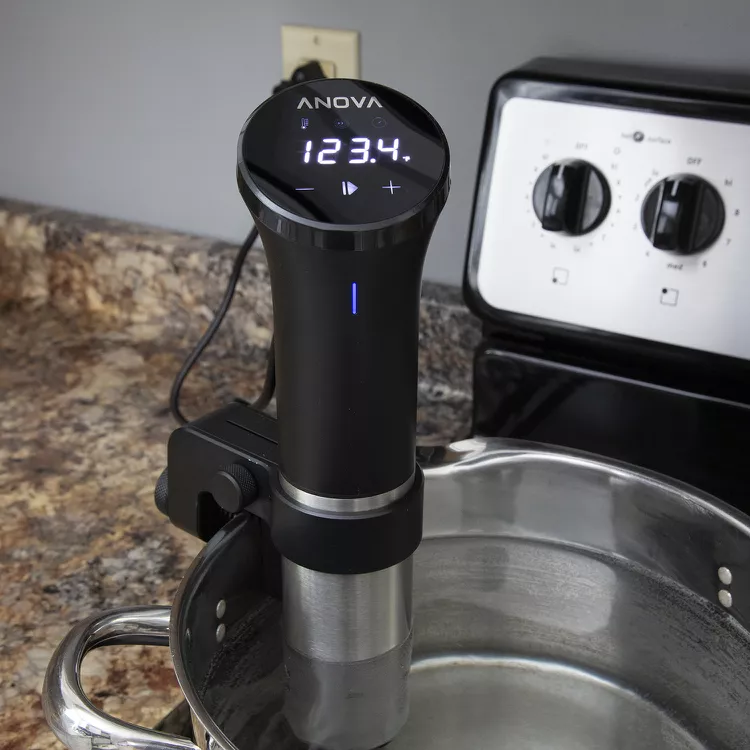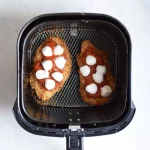- Precise temperature control
- Adjustable clamp
- Compact design
- Easy to clean
- Wi-Fi is unreliable
- A little noisy
- Doesn’t come with any bags
The Anova Precision Cooker has some issues with spotty Wi-Fi, but the advanced temperature control, ease of use, and consistent cooking make up for the lack of reliable smart features.
We purchased the Anova Precision Cooker so our reviewer could put it to the test in their kitchen. Keep reading for our full product review.
Anova is one of the top names in sous vide-style cooking, so it’s no wonder there are three models to choose from. The Precision Cooker is the original model that falls in between the other two (the Precision Cooker Nano and the Precision Cooker Pro) in terms of power and price. With advanced temperature controls, it promises to give perfect results every time—but does it?
I put it to the test with all the sous vide favorites—steak, chicken, and soft-boiled eggs—to find out.
Design: Compact and adjustable
Unlike Anova’s Precision Cooker Nano, which has an all-black design, the Precision Cooker is two-toned with a black upper body and stainless steel base that goes into your pot of water. Aside from that, the two are almost identical in design. While the Nano was originally intended to be a smaller version of the Precision Cooker, the original got a redesign due to customer feedback. It went from 14.8 inches tall to 12.8 inches tall, which is the exact same height as the Nano. Because of this, they take up about the same amount of space in your drawer or cabinet. But the Precision Cooker brings more power (more on that later).
There’s a relatively large digital control panel on top of the cooker that makes it easy and intuitive to operate, thanks to the touch screen and picture icons. One notable difference is that the clamp on the Precision Cooker is adjustable (the Nano has a fixed clamp), so you can move the cooker up or down in your pot to get a perfect position. This gives you a little more leeway with pot size and water level, which is something that I thought the Nano was missing.
:max_bytes(150000):strip_icc():format(webp)/Anova_Precision_Cooker_02-51a4616e7f994fc8aaf99a8a70295a44.jpg)
Setup Process: Plug-in and cook
There’s no setup involved in the Precision Cooker itself, but if you want to control it remotely through the app, you’ll have to download the app and connect the cooker with the integrated Wi-Fi. Since I previously tested the Nano, I already had the app downloaded, but had to connect this specific model to it—a process that only took a minute or so.
Because the cooker also has controls on the touchscreen, you don’t have to connect it to the app if you prefer to control it manually, but the app lets you monitor it as it goes or control it from another room, which is convenient when you’re working with the lengthy cooking times that go hand-in-hand with sous vide cooking. I didn’t find myself using the app other than to browse through recipes, but it’s a nice additional touch if you’re into it.
While I was highly impressed with the precise cooking, the Wi-Fi cut in and out pretty frequently.
Once the cooker was connected to the app, I clamped it on the pot with the turn knob, making sure that it was firmly in place, set the temperature on the touchscreen, and let it do its thing.
Features: Wi-Fi-enabled
The Anova Precision Cooker is more about function than features, but it’s well thought out and has everything you need to make sous vide cooking easy, even if you’re a beginner. This model, which has been redesigned from earlier versions based on customer feedback, has a large touchscreen that lets you control time and temperature directly on the cooker, and a +/- 0.2-degree Fahrenheit accuracy.
While the Nano and the original model of this sous vide cooker connect to the app via Bluetooth, this updated Precision Cooker is Wi-Fi enabled, which gives you a greater range of connectivity and a faster response time (in theory—I had some issues with that). The Wi-Fi works only with 2.4 GHz networks and not 5G networks, though, so keep that in mind when deciding if it’s right for you. You can also control the sous vide cooker completely manually without the need for Wi-Fi, but this feature makes things a little more convenient if you want to monitor your cooking remotely.
The sous vide cooker also comes with a free app that provides cooking guides, how-tos, and recipes for all types of meals. Granted, you can still access this app even without the cooker, but it’s a nice feature that allows you to learn the ropes and follow along with recipes if that’s how you like to cook.
Performance: Cooks with precision
When testing the Anova Precision Cooker’s performance, I wanted to make sure I stayed consistent with the foods I was using with the other two models, so I cooked steak, eggs, and chicken. Starting with the steak, I filled a 10-quart stockpot with water and adjusted the cooker so that the water line was positioned between the minimum and maximum markings. Because the clamp is adjustable, I had an easier time with this than with the Nano even using the same size pot.
One notable difference is that the clamp on the Precision Cooker is adjustable (the Nano has a fixed clamp), so you can move the cooker up or down in your pot to get a perfect position.
The water heated up faster, too. It took about 17 minutes when set to 130 degrees compared to the 30 minutes of the Precision Cooker Nano with the same amount of water. While that definitely helped move things along a little faster, it still seemed like a lengthy amount of time to wait before you even start the cooking process. Of course, time will vary based on the volume of water and the type of container you’re using.
It’s a bit louder than the Nano, but that was to be expected with a more powerful motor. The sound wasn’t intrusive—more of a slight humming—but you definitely know it’s on when it’s running. Like the other Anova models, this one doesn’t come with any bags, so you’ll have to pull out your vacuum sealer or use any standard heavy-duty food-safe freezer bag. This time, I used a freezer bag, followed the steak recipe from the Anova app, and got to cooking.
Once the water got to temperature, I put the steak in and monitored it as it went. The displayed temperature rarely ever moved from the 130 degrees I set it to, which showed that the Precision Cooker was able to keep the water bath at the controlled temperature for the entirety of the cooking process, which took two hours (just like with the Nano). When the steak was done cooking, I transferred it to a hot skillet, searing both sides for about a minute and a half each to get a nice crust. After letting the steak rest for five minutes, I cut into it to see how the Precision Cooker did with the cooking.
The inside was nice and pink with a brown crust around the edges: perfectly medium-rare. The steak was also tender and juicy, considerably more so than when I cook steak on the grill. As with my Nano testing, I also cooked soft-boiled eggs and chicken following Anova’s recipes in the app. The cooking was equally impressive for all of them, albeit the time it takes to get through the cooking process is significantly longer than if you were to just soft boil eggs in a pot on the stove.
While I was highly impressed with the precise cooking, the Wi-Fi cut in and out pretty frequently. At first, I thought this was due to my unreliable connection—a problem I was already aware of—but after digging into some reviews, I saw that this seemed to be a common complaint. If you’re looking to upgrade to this model based on the fact that it has Wi-Fi, you may be disappointed.
:max_bytes(150000):strip_icc():format(webp)/Anova_Precision_Cooker_04-62bdbb2644c344b28ebcc1d75560a052.jpg)
Cleaning: Rinse and pat dry
The Anova Precision Cooker really only touches water most of the time, so all I had to do to clean it was give it a quick rinse under running water and then pat dry with a clean paper towel. I haven’t run into a problem with any of the bags breaking, but if they do, or if gunk starts to build up, you can deep clean the Precision Cooker by adding dish soap to a pot of water, attaching the Precision Cooker, setting it to 158 degrees, and letting it run for 30 minutes. There’s really no cleanup process that’s easier than that.
The displayed temperature rarely ever moved from the 130 degrees I set it to, which showed that the Precision Cooker was able to keep the water bath at the controlled temperature for the entirety of the cooking process.
Price: On par with others in its class
At a retail price of $219, the Anova Precision Cooker is right in line price-wise with other models in its class. While there are less expensive models out there, most of them don’t come with smart features or the advanced precision of the Anova.
Competition: Battle of the Anovas
Because there are three Anova models—and they’re all very highly rated—it makes sense to pit them against each other to see which one is the best for you and your needs.
Anova Precision Cooker Nano: The Nano could be considered Anova’s entry-level model. While it’s about the same size as the regular Precision Cooker, it does have less power, which means it takes longer for the water to heat up—something that translates to more waiting time. It also doesn’t have an adjustable clamp, so you have less leeway in the pot or container size you’re using. However, it does an excellent job with cooking all the foods I tested and it retails for less than the Precision Cooker.
Anova Precision Cooker Pro: If you want to go in the opposite direction, the Precision Cooker Pro is Anova’s luxury model. It’s double the price of the Precision Cooker, but it has 1,200 watts of power and more precise temperature control—it has a temperature accuracy of +/- 0.09 degrees, compared to the Precision Cooker’s +/- 0.2-degree accuracy. If you need that kind of precision, and you don’t mind paying double, the Pro is a top-of-the-line cooker.
Sticks to its promises.
Thanks to a redesign, the Anova Precision Cooker is every bit as compact as the Nano but with more power, faster heating times, and upgraded connectivity options. If you can afford the price increase, the upgrade is worth it.
Specs
- Product NamePrecision Cooker
- Product BrandAnova
- Price$219.00
- Weight1.6 lbs.
- Product Dimensions5.3 x 12.8 x 3.1 in.
- Flow Rate8 liters/min
- Temperature Range32 to 197F
- Wattage1,000



